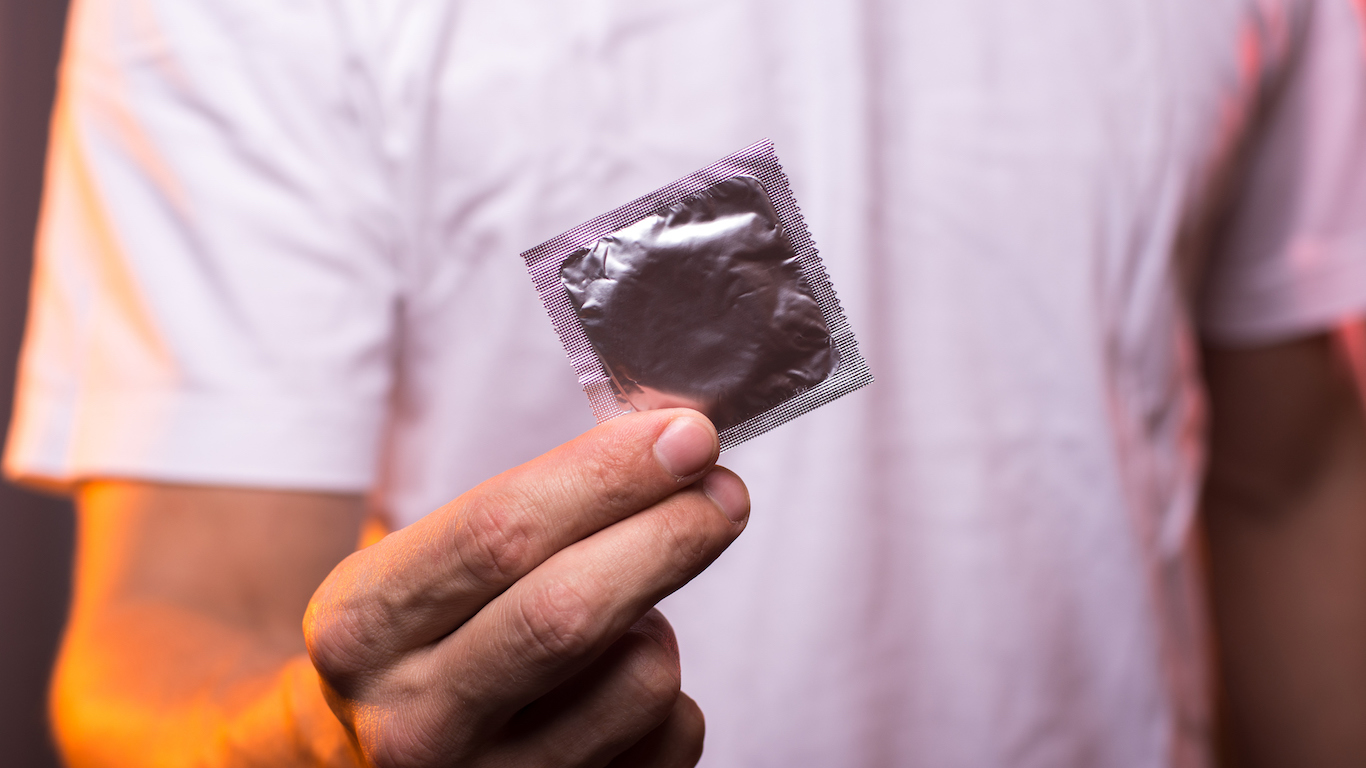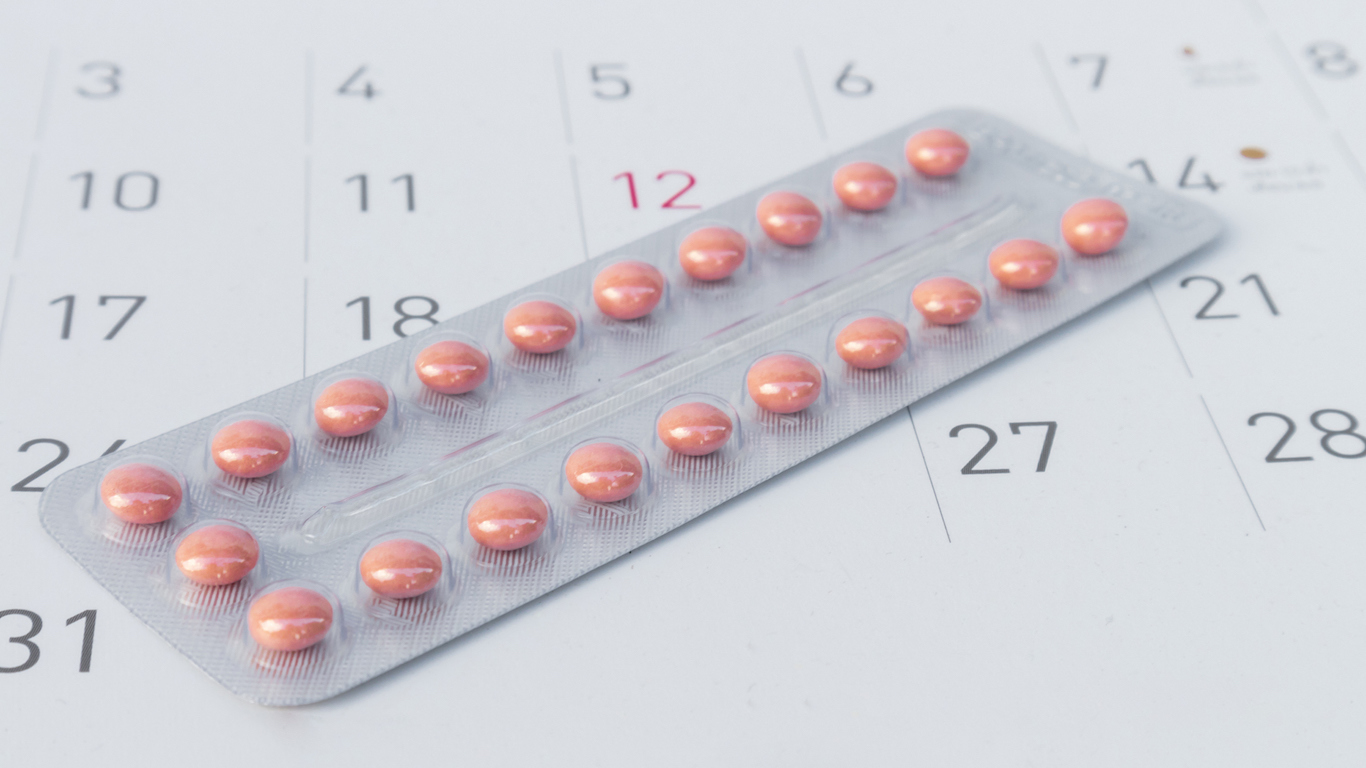Special Report
The Most and Least Effective Birth Control Methods

Published:
Last Updated:

The idea of contraception has been around for thousands of years as a way to prevent pregnancy. While some of the first written descriptions of contraception appear as early as 1550 B.C., the safest and most effective methods of birth control were developed and refined in the 20th and 21st centuries.
To determine the most and least effective birth control methods, 24/7 Wall St. analyzed data from the Centers for Disease Control and Prevention for the most common forms of contraception. The most effective birth control methods led to 12 or fewer pregnancies in every 100 women, and the least effective methods led to 18 or more pregnancies per 100 women.
[in-text-ad]
The effectiveness of a contraceptive method does not correlate with the rate of usage, as some of the least effective methods are the most common. The leading form of birth control in the United States is the oral contraceptive pill, used by 9.7 million women. With a 9% failure rate, the pill is less effective than five other major forms of birth control. The second most common form of birth control, female sterilization, is the fourth most effective contraceptive.
Click here to see the most and least effective birth control methods.
While the most effective methods of birth control are a statistically surefire way to avoid unwanted pregnancy, they do not completely eliminate the risks associated with sexual intercourse. According to the CDC, some the most common sexually transmitted diseases in the United States are chlamydia, gonorrhea, and syphilis. The CDC estimates that nearly 20 million Americans contract an STD each year. The CDC recommends always using a condom to reduce the risk of contracting a STD.
Widespread access to methods of contraception is one of the hallmarks of a developed country and a major prerequisite of gender equality. The presence of family planning assistance in a country has been associated with a rise of female participation in the workforce. Approved by the Food and Drug Administration in 1960, the oral contraceptive pill was one of the first widely available birth control measures in the United States. The pill, as well as the introduction of new forms of intrauterine devices several years later, contributed to an increase in graduation and college attendance rates among women, as well as a rise in female workforce participation. Female workforce participation rose from 36.6% in March 1960 to 57.1% in March 2017.
In many developing countries, however, the widespread need for potentially life-saving birth control is not being met. The Guttmacher Institute estimates that roughly 222 million women worldwide have an unmet need for modern contraception, the majority of whom are in poor, developing countries. Given the poor medical infrastructure and high rates of infant and maternal mortality in many developing countries, providing birth control to all women in need of contraception could prevent 79,000 maternal deaths and 1.1 million infant deaths.
To determine the most and least effective birth control methods, 24/7 Wall St. analyzed data from the Centers for Disease Control and Prevention for the most common forms of contraception. The birth control methods with the highest failure rates were considered the least effective, and the lowest failure rates the most effective. Failure rates refer to the number out of every 100 women who experienced an unintended pregnancy within the first year of using the contraceptive method. Data on usage rates for the most and least effective methods of birth control among all female contraceptive users in the U.S. are for 2012 and came from the Guttmacher Institute.
These are the most and least effective forms of birth control.

15. Spermicide
> Failure rate: 28%
> Popularity: <0.1% of women who practice birth control
> Method: Over-the-counter
One of the oldest birth control methods and first mentioned around 1850 B.C., spermicide has since been surpassed by many far more effective contraceptive methods. Spermicide is used to kill sperm and is available in forms such as cream, film, foam, or gel. The most common active ingredient is called nonoxynol-9, which prevents pregnancy by inhibiting sperm motility, causing the sperm to move slower towards the egg. By itself, spermicide prevents just 72% of pregnancies, the least effective of any major contraceptive measure. Because of its poor success rate, spermicide is often used in conjunction with other contraceptives such as patches and condoms.
[in-text-ad]

14. Fertility-awareness based methods
> Failure rate: 24%
> Popularity: 1.4% of women who practice birth control
> Method: N/A
While each woman has a different menstrual cycle, the average woman is most fertile during ovulation, which is roughly two weeks after the first day of her period. Women are also often least fertile just before menstruation. Fertility-awareness methods are ways to track the menstrual cycle and ovulation times. Women can prevent pregnancy by abstaining from intercourse during the fertile days. However, the process is far less effective than other medical or surgical methods of birth control. Out of every 100 women using fertility-awareness based methods as their primary form of contraception, 24 experienced an unwanted pregnancy, nearly three times the rate of women using birth control pills, patches, or rings.

13. Sponge
> Failure rate: 12%-24%
> Popularity: <0.1% of women who practice birth control
> Method: Over-the-counter
The sponge is a small, round piece of white plastic foam containing spermicide. It is about two inches across and has a small nylon strap to aid in removal. Like the diaphragm, the sponge is inserted into the vagina prior to sex. The sponge acts as a physical blockade between the cervix and sperm. It also releases spermicide that inhibits sperm motility and slows their movement. One benefit of sponges is that, unlike many other forms of birth control, they lack hormones, which can often have undesirable side effects. However, the sponge has been proven to be far less effective than hormonal methods, especially for women who have already had a child. Roughly 12% of women who regularly use the sponge as a contraceptive become pregnant within a year, and among women who have previously given birth in their lifetime and use the sponge, 24% become pregnant.

12. Withdrawal
> Failure rate: 22%
> Popularity: 4.8% of women who practice birth control
> Method: N/A
The withdrawal method, known as coitus interruptus, is a contraceptive method that involves the man withdrawing his penis from the woman’s vagina prior to ejactulation in order to prevent sperm from entering the uterus. The method requires a degree of self-control and can be ineffective even when done properly, as the penis often emits pre-ejaculation fluid containing sperm. While more than one in five women using the withdrawal method as a primary form of contraception have unwanted pregnancies, coitus interruptus remains a popular method of birth control. An estimated 5% of of couples in the United States who use some method of contraception use the withdrawal method, and 10% of couples use the method in conjunction with another form of birth control.
[in-text-ad]

11. Female condom
> Failure rate: 21%
> Popularity: <0.1% of women who practice birth control
> Method: Over-the-counter
Male and female condoms are the only contraceptive methods that also protect against STDs. The female condom is a pouch inserted into the vagina. Invented years after the male condom, the female condom was partially developed in response to the refusal among men to wear a male condom and to put women in control over the decision to use protection. The female condom is both less popular and slightly less effective than the male condom. While both are a physical barrier to block sperm from the uterus and should theoretically have a 100% success rate, the misuse of condoms has decreased the device’s effectiveness. More than one in five women who use female condoms as their primary source of birth control have unwanted pregnancies each year.

10. Male condom
> Failure rate: 18%
> Popularity: 15.3% of women who practice birth control
> Method: Over-the-counter
While male condoms are one of the most commonly used forms of birth controls, they are among the least effective. An estimated 93% of sexually active women have their partners use condoms. While advocacy group BirthControl.com estimates that condoms should be 98% effective by design, the misuse of condoms lowers the method’s effectiveness to just 82%. Users may put the condom on incorrectly, or it may break. Only 35% of public and private high schools in the U.S. teach their students how to properly use a condom as part of their sexual education curriculum. Condoms are also used as a primary means of STD prevention.

9. Diaphragm
> Failure rate: 12%
> Popularity: <0.1% of women who practice birth control
> Method: Prescription
Over a one-year period, 12% of women using diaphragms as their regular method of birth control reported unexpected pregnancies. A diaphragm is a dome shaped cup made of silicone, just a few inches in diameter, which is inserted into the vagina prior to sex. The diaphragm covers the cervix and acts as a physical barrier to keep sperm from entering the uterus. For optimal protection, doctors recommend inserting the diaphragm into the vagina several hours before sex and to leave it in for six to eight hours after the man’s ejaculation. The effectiveness of the technique may also be improved by using it with spermicide.
[in-text-ad]

8. Ring
> Failure rate: 9%
> Popularity: 2.0% of women who practice birth control
> Method: Prescription
Vaginal rings contain the hormones estrogen and progesterone — the same hormones used in birth control pills. Estrogen and progesterone prevent the egg from leaving the ovaries and thicken the mucus layer around the cervix, preventing sperm from fertilizing the egg. The vaginal ring is inserted into the vagina once a month and is removed after three weeks. The ring is 92% effective — only eight in 100 women using the ring report unintended pregnancies in a given year.

7. Patch
> Failure rate: 9%
> Popularity: 0.6% of women who practice birth control
> Method: Prescription
A contraceptive patch is a thin bandage-like piece of plastic less than two inches wide and two inches across that is applied to the user’s skin. Like vaginal rings, the contraceptive patch prevents pregnancies by secreting the hormones estrogen and progesterone into the body, which prevent the egg from leaving the ovaries and thickens mucus around the cervix, which prevents the sperm from reaching the egg. The patch is one of the most effective forms of birth control, preventing 91% of all unwanted pregnancies. It is also one of the easiest and less intrusive methods.

6. Pill
> Failure rate: 9%
> Popularity: 25.9% of women who practice birth control
> Method: Prescription
The Food and Drug Administration approved the active ingredient in today’s birth control pill in 1957. Oral contraceptives became popular by 1965, when one in four married women under age 45 were taking birth control pills. The oral contraceptive is the most commonly used method of birth control today, used by 9.7 million women. The oral contraceptive once required a monthly regimen by which a woman takes one pill daily for three weeks, followed by a seven day break period with no pills or placebo tablets as a method of maintaining habits. Women have more options today, with some extended-cycle pill regimens lasting from three months of taking active pills every day to one year. Today, 26% of all women using contraception use birth control pills as their preferred method.
[in-text-ad]

5. Injectable
> Failure rate: 6%
> Popularity: 4.5% of women who practice birth control
> Method: By appointment
The first injectable contraceptives were developed in the 1950s. By combining progestogen — a hormone that controls ovulation — and alcohol, scientists discovered the possibility of a long-lasting contraceptive that would require far less frequent administration than the most popular birth control at the time, which had to be taken orally nearly every day. Today, birth control shots, also called Depo-Provera, are easily available by prescription and last three months. Shots are one of the most effective method of birth control, with a failure rate of only 6%. Like most methods on this list, birth control injections do not protect against STDs.

4. Female sterilization
> Failure rate: 0.5%
> Popularity: 25.1% of women who practice birth control
> Method: Surgery
While the earliest references to female sterilization can be traced as far back 1823, the safe and effective method used today was developed in the 1970s. Female sterilization involves the blocking of the fallopian tubes, thus preventing the egg from traveling from the ovaries to the uterus and preventing the sperm from reaching the egg. While the method was originally developed for eugenic reasons as a means of preventing the flow of hereditary disease, the growing popularity of birth control in the 1960s and the invention of the less invasive Essure procedure in 2002 has made the surgery one of the most popular contraceptive methods. Today 15.5% of U.S. women between the ages of 15 and 44 have undergone the procedure. The CDC estimates that just 0.5% of women with tubal sterilization become pregnant each year.

3. Intrauterine device (IUD)
> Failure rate: 0.2-0.8%
> Popularity: 10.3% of women who practice birth control
> Method: By appointment
Developed and refined in the 1960s, the intrauterine device is one of the most effective and popular forms of birth control. An IUD is a small, T-shaped device that is inserted into the uterus to prevent pregnancy, and it lasts from three to 10 years. There are multiple types of IUDs, such as copper and hormonal. Copper is toxic to sperm and makes the uterus and fallopian tubes secrete fluid that kills sperm. Just 0.8% of women using copper IUDs become pregnant. While copper IUDs are the most common form of intrauterine device, hormonal IUDs are the most effective. Hormonal IUDs release small amounts of progesterone into the uterus each day, the same hormone used in patches and vaginal rings. IUDs are one of the most effective form of birth control and women can return to fertility within several days of removing the device.
[in-text-ad]

2. Male sterilization
> Failure rate: 0.15%
> Popularity: 8.2% of women who practice birth control
> Method: Surgery
Slightly more effective than female sterilization, only 0.15% of couples whose primary form of birth control is male vasectomy become pregnant each year. While technically reversible, vasectomies are a form of permanent contraception that requires only one surgery. The procedure involves the blocking of the vas deferens, the tubes that carry sperm. Once the tubes are cut, blocked, or tied, sperm is unable to leave the man’s penis and cannot cause pregnancy. Getting a vasectomy is a relatively quick process, often requiring just 30 minutes of surgery and one hour of short rest. While male sterilization is one of the most effective forms of contraception, the permanence of the procedure limits its popularity to mostly older men who have decided they do not want children in the future. The average age of a man who gets a vasectomy is 38.

1. Implant
> Failure rate: .05%
> Popularity: 1.3% of women who practice birth control
> Method: By appointment
An implant is a small, matchstick-sized rod inserted beneath the skin of a female’s upper arm. The implant releases progesterone, the same hormone used in patches and vaginal rings that prevent ovaries from releasing eggs and thickens the cervical mucus, blocking sperm from reaching a woman’s eggs. Once inserted, the implant lasts about four years. In addition to its convenience, the implant is the most effective contraceptive method available. Just 0.5% of women using implants as their primary form of birth control have unwanted pregnancies.
If you’re one of the over 4 Million Americans set to retire this year, you may want to pay attention. Many people have worked their whole lives preparing to retire without ever knowing the answer to the most important question: am I ahead, or behind on my goals?
Don’t make the same mistake. It’s an easy question to answer. A quick conversation with a financial advisor can help you unpack your savings, spending, and goals for your money. With Zoe Financial’s free matching tool, you can connect with trusted financial advisors in minutes.
Why wait? Click here to get started today!
Thank you for reading! Have some feedback for us?
Contact the 24/7 Wall St. editorial team.